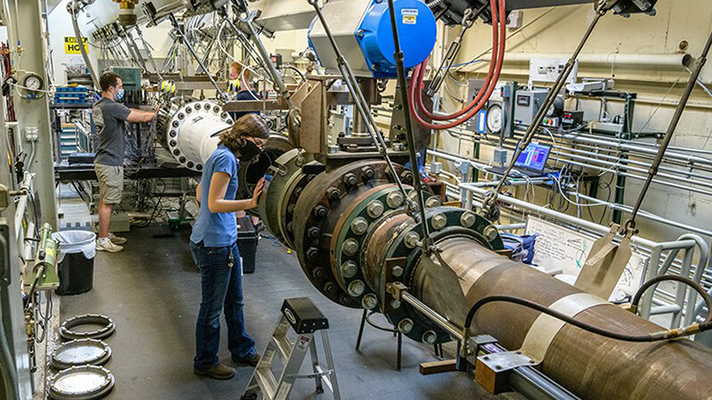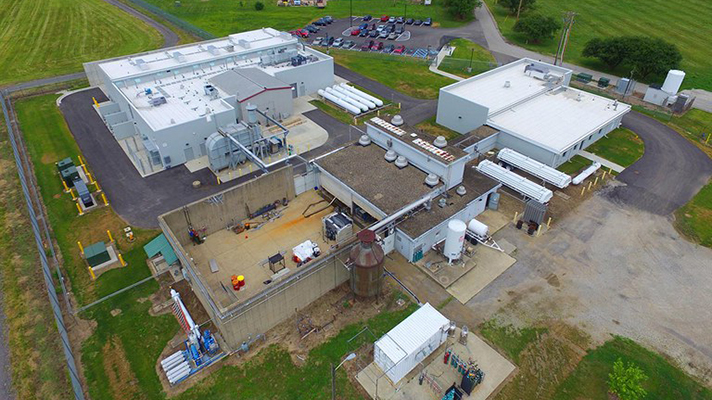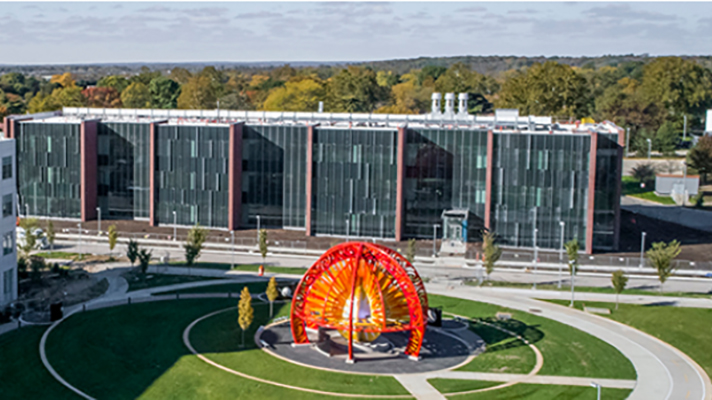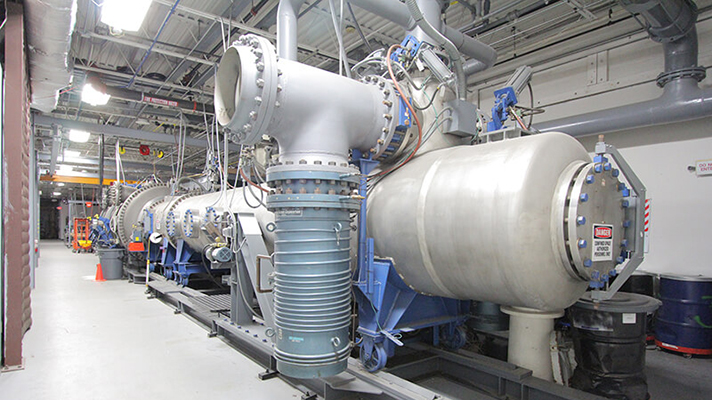
Boeing/AFOSR Mach 6 Quiet Tunnel
In 2001, Purdue University engineers finished building the one-of-a-kind Mach 6 quiet wind tunnel. The "Boeing/AFOSR Mach 6 Quiet Tunnel” was funded by the Air Force Office of Scientific Research, the Ballistic Missile Defense Organization and the Boeing Company. Additional funding over the years from Ballistic Missile Defense Organization, Sandia National Laboratory, and a gift in memory of Kenneth Hobbie, helped the “BAM6QT” to be the only one of its kind in the world capable of running quietly at "hypersonic" speeds, helping researchers to design advanced aircraft and missiles.
The BAM6QT has a 9.5-inch exit diameter, runs for about 10-sec., uses Ludwieg tube concept, and is designed to achieve laminar nozzle-wall boundary layers for study of laminar-turbulent transition processes under low-noise conditions comparable to flight.

Maurice J. Zucrow Laboratories
The Zucrow Labs research facilities occupy a 24 acre site adjacent to the Purdue University Airport. The Laboratory's research capability encompasses many disciplines: aerodynamics of turbo machinery, aeroacoustics, combustion, measurement and control, computational fluid mechanics, particle flow heat transfer, and atomization processes.
Founded by Maurice J. Zucrow in 1948, Zucrow Labs is the largest academic propulsion lab in the world.
Materials and Manufacturing
Purdue University’s multidisciplinary approach to materials and manufacturing in the hypersonics realm is reflected via many world class labs stretching across the West Lafayette campus.

Advanced Computational Materials and Experimental Evaluation (ACME) Laboratory in the School of Aeronautics and Astronautics combines knowledge of materials science, solid mechanics, and advanced manufacturing to solve complex problems in materials behavior and processing.

Composites Manufacturing & Simulation Center (CSMC), is a Purdue Center of Excellence. The CMSE is a collaboration of the College of Engineering and Purdue Polytechnic Institute and a leader in the education and training of a new generation of engineers. This Purdue Research Park center is a technology area of the Institute for the Advanced Composites Manufacturing Innovation.
- Composites Manufacturing Simulation & Validation
- IN-MAC - Indiana Next Generation Manufacturing Competitiveness Center
- Composites Additive Manufacturing
- Mechanics of Structure Genome
- The Composites Design and Manufacturing HUB (cdmHUB).

Purdue Energetics Research Center
Faculty and staff at Purdue University have joined efforts to form an interdisciplinary team with an overriding focus on Energetic Materials. The Purdue Energetics Research Center (PERC)'s research addresses existing and emerging explosives-based threats to civilian and military infrastructure, commerce, and aviation. It also targets the U.S. military’s need for more stable, more effective, less sensitive, and more easily processed energetic materials for use as propellants, pyrotechnics and in ordnance.
PERC facilities that allow for synthesis and fabrication, diagnosis and characterization, detection and defeat are as follows:

Hypersonic Pulse Shock Tunnel
Purdue University is adding a Hypersonic Pulse (HYPULSE) shock tunnel to its expanding array of facilities to research aspects of hypersonic flight. The tunnel was donated by Northrop Grumman Corp. Once installed in Purdue’s future Hypersonics and Applied Research Facility, Purdue will be only the second university in the U.S. to offer such a hypersonics test capability. The HYPULSE tunnel will allow flight simulations at speeds ranging from Mach 5 to as high as Mach 40; and will be available to researchers from academia, industry and government for testing.
Mach 8 Quiet Wind Tunnel
Purdue University, with major support from the Air Force Research Laboratory, is developing the first quiet Mach 8 wind tunnel in the world, further solidifying Purdue’s and the state of Indiana’s major role in one of the U.S. Department of Defense’s top technological priorities – the development of hypersonics systems.
The Mach 8 quiet wind tunnel will be the first facility of its kind capable of collecting data at speeds greater than Mach 6. The new tunnel, under development and construction, will be housed in the new Hypersonics and Applied Research Facility. This future location, scheduled to begin construction in Fall 2021, will be a 65,000-square-foot facility, capable of housing Purdue’s HYPULSE wind tunnel and the Mach 8 wind tunnel.